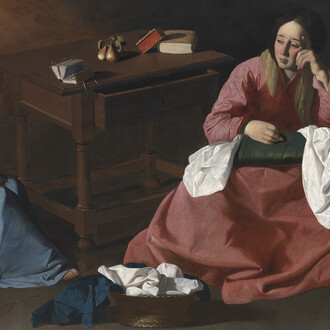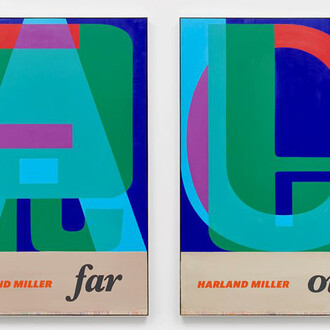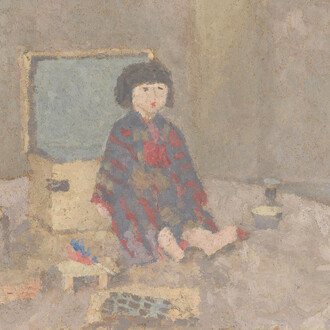*In 2013 with Returner, Your life was into my mouth and Everest you took part at Rosenfeld Porcini Gallery's group exhibition "The Birth of Cinema…and Beyond" exploring the way in which the idea of virtual cinema existed in human imagination before the invention of cinema, and reflecting on the influence of cinema on contemporary artists. In these three works the kaleidoscopic perspective imitates the lens of a film camera: why and when did you decide to adopt this tecnhique?
*The Everest painting is based on a photography of the first Mount Everest expedition of Edmund Hillary and Tenzing Norgay but the other two paintings are more or less related to a cinematic view - I do not paint so many pictures in a horizontal format as it's always a problem of how to use the space on the canvas to show a figure - it was an experiment to use the medium shot of a film camera to structure the paintings. On Returner I tried to get a little bit further and I used abstract forms which can be read as an overexposed film or the moment when a frame fades into the next.
Despite your contemporary technique and according to the classical aestethics, you let viewers discover their own cinematic scene, with a passage from the cinema objective narration to a subjective story telling. Is there any connection between the cinematic experience of viewers you aim to and your preferred narrative form?
I'm interested in films where two different kind of stories are told - on one hand the narrative plot and on the other something, which is all about form. For example, the film Red Desert of Michaelangelo Antonioni, which is about a woman trying to survive in the modern world of cultural neurosis and existential doubt. On the other hand, it's about the industrial technology itself, the architecture and the urban sound. There are some scenes, which don't make so much sense in a narrative way, they are much more about formal questions. It's the same with my paintings: the narration is just one way to start looking at my works. After a while it should not matter if you look at a painted face or an abstract form of paint, which interests you, as they are all related to each other.
You and cinema, what about this relationship?
In cinema there exist moments, images if you like, which are so strong that they have their own independent existence beyond the story of the film. I love these moments. I try to create something similar. It does not matter what happened before or what will happen after, it's just about the moment itself.
In 2012 you painted Silent Movie. Was it a statement of esteem for silent films?
I decided to use this title after I finished the painting - somehow the figures remind me of silent movie actors. Also, there's a specific sadness in the picture, which now can be seen as an homage to silent movies.
Have silent movie posters ever fascinated you?
Not really, as I mentioned above the title came after I finished the painting. I did not start with the idea of painting a silent movie-painting.
In Silent Movie the man's right eye reminds those painted by the Austrian artist Egon Schiele. Not a coincidence, as well as it is not a coincidence that the artist you portrayed in The Austrian painter is Schiele, a tribute to a photograph with the artist looking into a mirror. What drives your admiration towards him?
The resemblance of the eye is somehow a coincidence when it happened. This is the way I work: I usually start to paint very freely and abstract in an improvisational manner and some results I try to keep and work with and others I erase again; then, there is a thinking process, when something starts to interest me the concious part of painting begins. I'm interested in Schiele not only because of his work, I like the person himself, especially on the photograph where he is looking into a mirror; he seems very fragile, almost like Peter Pan and in this instance also like Christoph Schlingensief. Someone who forces himself to create something meaningful - it's a very romantic figure.
Is Schiele the slim man you portrayed in Master and Everyone?
It's very important for me that there is not a right or wrong way of reading my paintings; if you like to read it that way it's interesting. Someone told me (I think also because of the exhibition text and the idea of Austrian tradition) that the left figure looks like Sigmund Freud. I used two different photos - the left one is the singer Will Oldham and the right one is Blixa Bargeld of Einstürzende Neubauten. I liked the idea of them sitting together and talking. They make very different kind of music but somehow I think they are interested in a very similar topic.
In your works blue used to be marginal but in recent times, as in Pink Moon, it has become the main one. Green anyhow is the colour dominating more and more your works. A homage to Oskar Kokochka?
I like the early paintings of Kokoschka, especially the portraits - they are very psychological. But how I choose colours is a very natural and spontaneous process - there is not really an idea of making a homage; it's like producing music: this album is more noisy, there is more distortion, the next one will maybe be more calm and quiet. Right now I see my paintings as songs with some text passages but also with very long instrumental parts. It's more about creating a specific sound than telling a story.
Interview by Stefania Elena Carnemolla



















